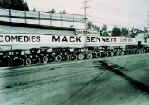
Excerpted from June, 1990 and March, 1991 articles by Ada Brownell in the SLRA Newsletter.
Part 1. The Studio
Originally the site was a horse ranch. It was purchased by the New York Motion Picture Company, which owned Keystone and Bison film companies. Later Mack Sennett acquired the property and created permanent sound stage buildings.
The studio building is still in existence. However, there have been multiple transformations since the original filming by the Keystone Company. The property was sold by Sennett in 1932.
In the mid-30s, the studio was used as an ice rink. It also contained a small theater on the second level. During WW II, hard maple floors were installed to provide an even and durable floor for the gliding wheels of King's Roller Palace.
Next, there was a western motif; it became the Palace Barn Dance. Tex Williams and his Western Caravan gave forth with "Smoke, Smoke, Smoke that Cigarette" along with other such memorable songs. A sign outside the building read, "Dancing 4 Big Nights a Week," which was later changed to ". . . 3 Big Nights," then ". . . 2 Big Nights," and finally the lights were turned off, the musicians packed up their instruments and the doors closed. Country music had not yet found the strength it needed to continue. There was one last musical stint: a recording studio rented the basement for awhile.
| As the 1985 photographs below show, the last occupant was the Center Theatre Group which stored scenery and wardrobe shops [there]. The scenery and costume shop serviced approximately twenty productions annually for the combined Music Center's Ahmanson Theatre and the Mark Taper. |
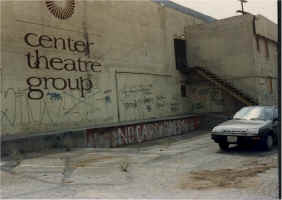 |
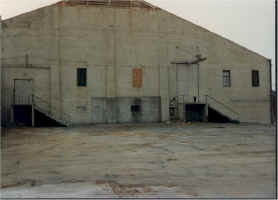 |
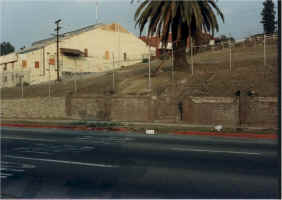 |
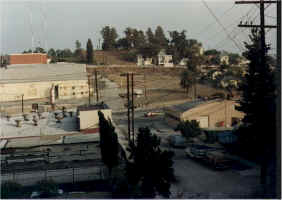 |
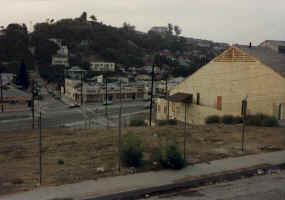 |
| Original Sound Stage | From Glendale Blvd | Looking East | Looking West | |
Today, the 2 ½ acre property is developed as storage units by Public Storage and includes preservation of the original 35,000 square-foot sound stage. The last film produced at this location by Mack Sennett was in 1928, and in 1982, it received Historic Landmark status, thanks to a group effort by the Hollywood Heritage, the LA Conservancy, preservationists, and film history buffs.
![]()
Part 2. Mack Sennett
In 1912, Ince, with Bison, and Sennett, with Keystone, went west. In August, 1912, The Motion Picture World reported:
"Mack Sennett, director, and Mabel Normand, leading woman of the Keystone Company of New York Picture Company, arrived in Los Angeles on August 28 as the advance guard of a new company which is to be located in the old Bison plant at Edendale." And a week later, the same magazine reported, "Preparations are also being made at Edendale for radical changes and extensions of the old Bison plant of the New York Motion Picture Company. Charles O. Baumann and Al Kessel are here from New York for a personal inspection of the plant and Mack Sennett, the director of the new Keystone Company, preceded them by a couple of days. Sennett, with the assistance of Mabel Normand Henry Lehrman and Ford Sterling, who came from New York with him, and Fred Mace, former director of Imp Comedies, is already at work at the Edendale plant making comedies for future release. The balance of the company was employed here, being recruited from the ranks of other companies on the grounds."
Sennett produced and directed early motion pictures that were slanted towards a mass audience. They were to be economically feasible and above all, entertaining. In these films, there was no elaborate plot or story development; rather, the films represented a "make it up as you go quality.
Del Mar Watson, a former Edendale resident, grew up with first hand knowledge of Keystone. In an interview, he explained that his family initially became part of Keystone based on the fact that they lived in the Edendale area. His father, Coy Watson, Sr., owned horses which were frequently rented by the studio. Watson Sr. would also be an Indian riding over the hills and the next day a cowboy who chased himself over the same hills. He was paid $3.00 a day plus an extra dollar for each fall.
The Watson family was large and often provided children and babies for the productions; this included Del Mar Watson. At one time, the porch of their house was knocked down for a Keystone film segment and later rebuilt by the company. Coy Watson Sr. went on to be a prop man, director, and special effects technician.
"Edendale--Where Stars Were Born" was an article in the Los Angeles Times, December 26, 1983. It quoted Coy Watson Sr. as he reminisced.
"The old man started out with just a box set. We shot everything outdoors at first. Had to setup reflectors to play the sunlight on the set."
Later, Sennett bought a neighborhood grocery store and turned in to his main studio. This, in turn, became the dressing rooms where the still-standing main stage was erected as the nucleus of a studio that extended for a couple of blocks along both sides of Glendale Blvd. "That was a real honey," Watson declared. "We had big incandescent lights and made our first indoor shots there."
The layout included a writers' building a row of dressing rooms along the boulevard, shops, garages, sets, and of course, a tank for the bathing beauties. "That was Sennett's big idea." said Watson. "Up until then, you know, women's bathing suits came clear to the wrist and ankle. The old man cut 'em way down -- pretty daring for those days -- dressed Gloria Swanson and the rest in them, and made a fortune."
One of the sets Watson recalled was an elaborate circular affair with scenery painted on it, which would spin like a merry-go-round while horses ran the other way in front of it. "Really looked like they were covering a lot of ground fast," Watson said. Above everything else was Sennett's tower, where the boss could sit and look over the whole studio. It had offices, conference rooms, and what Watson called, "the fanciest private bathrooms you ever saw."
Mack Sennett reinvented the slapstick and other techniques for his comedies. This included pie-throwing; the first pie thrown has been attributed to Mabel Normand. The chase was another signature feature of his films. Bathing beauties were a specialty of Keystone. They were first introduced because of a need to obtain more press space. There was no acting prerequisite for these young women; beauty would suffice. Sennett pushed risqué a couple of inches above the prevailing knee-length. As stated, there was a minimum of script and a maximum of improvising. Directors and actors were free to do their "thing" as long as the time schedule and budget were maintained.
The Keystone Cops were a flourishing group that incorporated all of Sennett's slapstick components: pie-throwing, the chase, and the bathing beauties. The Edendale area was well represented as a filming location. Glendale Blvd. was prominent for chase scenes. Echo Park Lake, when drained once, appeared as a lake whose plug had been pulled.
Mack Sennett worked with actors whose names are still remembered today: Charlie Chaplin, Gloria Swanson, Ford Sterling, Harry Langdon, Mabel Normand, Slim Summerville, Fatty Arbuckle, and scores more. We take our hats off to Mack Sennett and his colleagues for the laughter and entertainment they brought the world, and their pioneering of the film industry.
![]()
